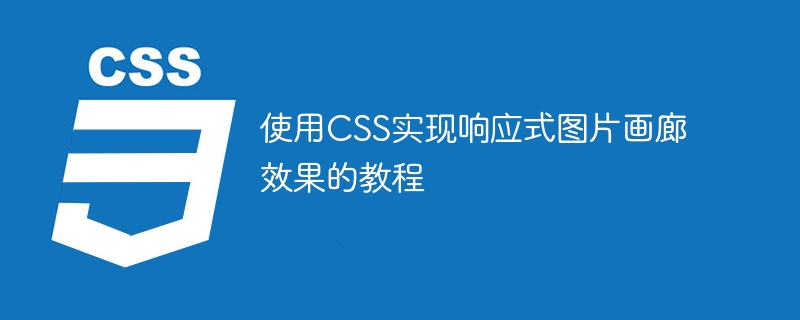

Tutorial on using CSS to achieve responsive image gallery effects
In modern web design, responsive design has become an important consideration. By using CSS to implement responsive image gallery effects, images can automatically adapt and present the best results on different devices. This article will share a simple and practical tutorial with specific code examples.
1. HTML structure
First, we need to create a basic HTML structure to present our gallery effect. Here is a simple example:
In this example,
![Tutorial on implementing responsive image gallery effects using CSS]()
2. CSS Style
In order to achieve responsive effects, we need to use CSS media queries to define styles under different device sizes. Here is a basic CSS styling example:
.gallery { display: grid; grid-template-columns: repeat(auto-fit, minmax(300px, 1fr)); grid-gap: 10px; } .gallery a { display: block; overflow: hidden; } .gallery img { width: 100%; height: auto; transition: transform 0.3s ease; } .gallery a:hover img { transform: scale(1.1); }
First, we set the.galleryelement to a grid layout and userepeat(auto-fit, minmax(300px, 1fr))Implement automatically adaptive picture column layout. This property will automatically adjust the number of columns based on the width of the container, with a minimum width of 300px for each column.
Next, we setdisplay: block;andoverflow: hidden;for.gallery ato ensure that the image is displayed correctly in the container .
Finally, we set the width of.gallery imgto 100%, and the height automatically adjusts to maintain the proportions of the image. We also added a simple zoom effect to the image, which will make the image larger when the mouse is hovered over it.
3. Add responsive functionality
Now, we already have the basic HTML structure and CSS style. Next, we'll implement responsive functionality by using media queries. Here is an example:
@media (max-width: 600px) { .gallery { grid-template-columns: repeat(auto-fit, minmax(200px, 1fr)); } } @media (max-width: 400px) { .gallery { grid-template-columns: repeat(auto-fit, minmax(150px, 1fr)); } }
In this example, we use media queries to adapt to two different device widths. For example, when the device width is less than or equal to 600px, we set the number of columns of.galleryto 2 columns, and the minimum width of each column is 200px. When the device width is less than or equal to 400px, we set the number of columns to 3 columns, and the minimum width of each column is 150px.
In a similar way, we can define our own style rules according to different device sizes to achieve a fully responsive image gallery effect.
4. Improve and expand functions
In addition to the basic responsive layout, you can also further optimize and expand the gallery effect. For example, you can add more CSS transition effects, or animate the gallery. You can also use JavaScript to implement more complex interactive functions, such as zooming in or switching displays when clicking on an image.
Summary
By using CSS to implement responsive image gallery effects, we can easily adapt to the screen sizes of different devices and present the best display effect. This article provides a simple tutorial and specific code examples, hoping to help you implement responsive gallery effects in web design. With continuous practice and exploration, you will be able to create more rich and diverse web design effects.
The above is the detailed content of Tutorial on implementing responsive image gallery effects using CSS. For more information, please follow other related articles on the PHP Chinese website!
 What is the difference between php7 and php8
What is the difference between php7 and php8 HP notebook sound card driver
HP notebook sound card driver How many years do you have to pay for medical insurance to enjoy lifelong medical insurance?
How many years do you have to pay for medical insurance to enjoy lifelong medical insurance? OuYi exchange usdt price
OuYi exchange usdt price How to restore videos that have been officially removed from Douyin
How to restore videos that have been officially removed from Douyin vps
vps Is it necessary to upgrade windows 11?
Is it necessary to upgrade windows 11? How to check the ftp server address
How to check the ftp server address



